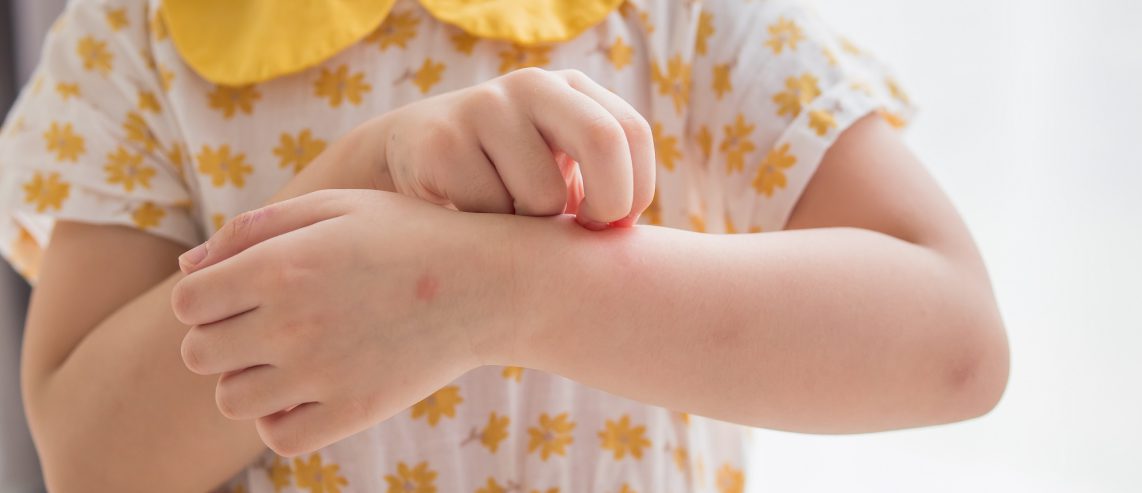Impetigo is a common skin condition in early childhood. It often appears as a few red sores or small blisters around your preschooler’s mouth or hands. A few days later, crusty yellow scabs form — it looks like someone coated the sores with brown sugar.
Here’s what you need to know about this contagious (but not usually serious) skin problem.
What Is Impetigo?
Impetigo is a common bacterial skin infection. Although anyone can get it, it most often affects children in the preschool years. Doctors treat impetigo with antibiotics.
Impetigo is very contagious. It spreads easily from person to person. It occurs more often in warm, humid weather.
Impetigo can be unsightly and annoying, but it is rarely serious.
Never Miss a Beat!
Subscribe to Our HealthBeat Newsletter!
Thank you for subscribing!
You can now select the specific newsletters you'd like to receive.
You are already subscribed.
Subscribe to more newsletters in our email preference center.
Sorry, an error occurred. Please try again later.
Get Healthy Tips Sent to Your Phone!
What Causes Impetigo?
Bacteria on the skin cause impetigo. The most common culprits are staphylococcus (staph) and streptococcus (strep) bacteria. Another increasingly common cause is methicillin-resistant staph aureus (MRSA).
Impetigo begins when there is a break in the skin from a bite, scrape, or cut. Germs already on the skin enter the cut or bite and start an infection. Children sometimes get impetigo after scratching at eczema or poison ivy.
You can get impetigo through direct contact with someone else’s infected skin. You can catch it if the fluid that seeps from someone’s blister touches an open area on your skin. You can also spread the infection by itching the infected area and then touching other parts of your body.
Impetigo can also spread through items that have touched infected skin. That includes towels, sheets, blankets, and clothing. The bacteria that cause impetigo may be able to live on surfaces for days or even weeks.
Risk Factors for Impetigo
Anyone can get impetigo. But you’re more likely to get it if you:
- Are between two and five years old.
- Have a scabies infection. Scabies is an itchy rash caused by mites that burrow under the skin.
- Have poor personal hygiene (not washing your hands, face, and body properly).
- Live in a tropical or subtropical climate with hot, humid summers and mild winters.
- Live in crowded conditions.
- Participate in sports or other activities where cuts and scrapes are common.
- Work in a group setting (i.e., daycare, school, or military training facility).
Impetigo Symptoms
Impetigo can occur anywhere on the body. But it’s most common around the nose, mouth, ears, hands, and forearms. On babies, it sometimes occurs in the diaper area.
Adults can get impetigo, although it’s not as common as in children. In adults, it most often occurs when people live in close contact with each other, or in a hot, humid environment.
There are three types of impetigo. The symptoms are slightly different in each one. They are:
- Bullous impetigo — this type of impetigo forms large blisters. They begin by looking clear, then turn cloudy. They tend to stay longer on the skin without bursting than other types of impetigo.
- Crusted impetigo — the most common type of impetigo, it starts as small blisters. The blisters eventually burst and leave weeping patches of red skin. They dry into yellow or honey-colored crusty patches and scabs.
- Ecthyma — this form of impetigo goes deeper into the skin. The ulcers have a “punched out” appearance and can sometimes leave a scar.
Serious complications from impetigo are rare. The most common complication is the rash spreading to other parts of the body. But left untreated, impetigo can potentially lead to kidney problems and rheumatic fever, which affects the heart, joints, brain, and skin.
How Do Doctors Diagnose Impetigo?
You should call your doctor if your child shows signs of impetigo, especially if a family member or classmate has recently had the infection.
Your child’s pediatrician can usually diagnose impetigo by examining the rash. They may take a sample from the affected area of the skin. A lab can confirm which form of bacteria caused the infection.
Doctors use different types of antibiotics to treat impetigo if MRSA is the cause.
Impetigo Treatment
Doctors treat impetigo in adults and children with antibiotics. They may prescribe a cream to put on the rash, or a medicine to take by mouth.
If the impetigo is in a small area, your doctor may prescribe an antibiotic ointment to use for five days.
If the ointment doesn’t work, or the rash has spread, your doctor will prescribe a pill or liquid. You typically take that medicine for seven to 10 days.
You should wash your child’s skin with antiseptic soap every day. Gently soak the crusted patches with warm, soapy water. That will help slowly remove the layers of dry crust.
Your doctor may recommend covering the infected areas with gauze and tape, or a loose plastic bandage. That will help keep your child from scratching the affected area and spreading the infection to other parts of the body.
Your child can usually go back to school or daycare 24 hours after you start treatment.
Call the doctor if:
- The area around the rash becomes bright red, warm, or tender.
- Your child develops a fever.
- Your child’s skin doesn’t begin to heal after three days of treatment.
Preventing Impetigo
The bad news is that you can get impetigo more than once. The good news? There are ways to reduce the chances of you or your children getting or spreading impetigo.
To prevent impetigo, you should:
- Clean and care for any minor wounds with soap and water.
- Cover any open wounds with a clean, dry bandage until they heal.
- Encourage your children to practice good hygiene, taking baths or showers regularly.
- Keep kids’ fingernails cut short so they don’t break the skin when scratching.
- Keep surfaces in your kitchen and bathrooms clean.
- Never share razors, soaps, or any other personal hygiene products.
- See your doctor for any deep cut or puncture wound.
- Take the full course of antibiotics the doctor prescribed. Even if the rash looks like it’s clearing up, it’s important to finish the medicine to get rid of the infection.
- Wash your hands frequently, especially after sneezing or coughing. It’s the best way to stop infections from spreading. (Use an alcohol-based hand sanitizer if soap isn’t available.)
- Wash your laundry frequently. If someone in your household has impetigo, you should wash their towels, linens, and clothes every day. They should never share them with someone else.
Sources
About UPMC
Headquartered in Pittsburgh, UPMC is a world-renowned health care provider and insurer. We operate 40 hospitals and 800 doctors’ offices and outpatient centers, with locations throughout Pennsylvania, Maryland, New York, West Virginia, and internationally. We employ 4,900 physicians, and we are leaders in clinical care, groundbreaking research, and treatment breakthroughs. U.S. News & World Report consistently ranks UPMC Presbyterian Shadyside as one of the nation’s best hospitals in many specialties and ranks UPMC Children’s Hospital of Pittsburgh on its Honor Roll of America’s Best Children’s Hospitals. We are dedicated to providing Life Changing Medicine to our communities.

